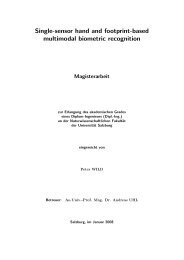Pit Pattern Classification in Colonoscopy using Wavelets - WaveLab
Pit Pattern Classification in Colonoscopy using Wavelets - WaveLab
Pit Pattern Classification in Colonoscopy using Wavelets - WaveLab
You also want an ePaper? Increase the reach of your titles
YUMPU automatically turns print PDFs into web optimized ePapers that Google loves.
2.3 Discrete wavelet transform<br />
From this equation it can be seen that the orig<strong>in</strong>al signal is expressed as a comb<strong>in</strong>ation of<br />
an approximation of itself (at an arbitrary scale <strong>in</strong>dex m 0 ), added to a succession of signal<br />
details from scales m 0 down to −∞. The signal detail at scale m is therefore def<strong>in</strong>ed as<br />
d m (t) =<br />
∞∑<br />
n=−∞<br />
T m,n ψ m,n (t) (2.18)<br />
hence equation (2.17) can be rewritten as<br />
x(t) = x m0 (t) +<br />
∑m 0<br />
m=−∞<br />
d m (t) (2.19)<br />
which shows that if the signal detail at an arbitrary scale m is added to the approximation<br />
at that scale it results <strong>in</strong> an signal approximation at an <strong>in</strong>creased resolution (m − 1).<br />
The follow<strong>in</strong>g scal<strong>in</strong>g equation describes the scal<strong>in</strong>g function φ(t) <strong>in</strong> terms of contracted<br />
and shifted versions of itself:<br />
φ(t) = ∑ k<br />
c k φ(2t − k) (2.20)<br />
where φ(2t − k) is a contracted version of φ(t) shifted along the time axis by step k ∈ Z<br />
and factored by an associated scal<strong>in</strong>g coefficient, c k , with<br />
c k = 〈φ(2t − k), φ(t)〉 (2.21)<br />
Equation (2.20) basically shows that a scal<strong>in</strong>g function at one scale can be constructed<br />
from a number of scal<strong>in</strong>g functions at the previous scale.<br />
From equation (2.13) and (2.20) and exam<strong>in</strong><strong>in</strong>g the wavelet at scale <strong>in</strong>dex m + 1, one can<br />
see that for arbitrary <strong>in</strong>teger values of m the follow<strong>in</strong>g is true:<br />
( )<br />
2 − m+1 t<br />
2 φ<br />
2 − n = 2 − m m+1 2 2<br />
− 1 2<br />
∑<br />
k<br />
( )<br />
2t<br />
c k φ<br />
2 · 2 − 2n − k m<br />
(2.22)<br />
which can be written more compactly as<br />
φ m+1,n = √ 1 ∑<br />
c k φ m,2n+k (t) (2.23)<br />
2<br />
k<br />
That is, the scal<strong>in</strong>g function at an arbitrary scale is composed of a sequence of shifted scal<strong>in</strong>g<br />
functions at the next smaller scale each factored by their respective scal<strong>in</strong>g coefficients.<br />
11








